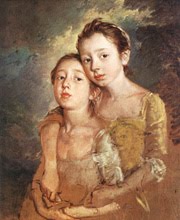This describes my training at the totally wretched "Boston Museum School"- minus the paint buckets.
| Eric Fischl, showing at the Mary Boone gallery in New York City [review written in 1988], has become the painter laureate of American anxiety in the eighties. From the moment that he exhibited "Sleepwalker", 1979, his image of a teenage boy resentfully jerking off in a suburban wading pool, Fischl has zeroed in on the discontents of the White Tribe whose territory stretches from Scarsdale to Anaheim: unreachable kids, grotesque parents, small convulsions of voyeurism and barely concealed incestuous longing. This is the suburb as "failed Eden," as noted by three out of three American sociologists and not a few novelists. But Fischl's project is not to embroider clichés on it. Rather, he finds images that seem to trail a whole narrative history behind them, but obliquely so that you, as viewer, are put at the threshold of a hidden life that may, if you look closer, be yours. Fischl is a true American realist, but he works at a pitch of psychological truth (especially about adolescent sexuality) not known in American narrative art in the thirties. When Fischl started out to paint, the odds were against the very idea of narrative painting based on the human figure. Born in New York City in 1948, he went to art school in 1970 at the California Institute for the Arts in Los Angeles just at the height of the belief, then endemic in the American art world, that Painting was Dead. Cal Arts epitomized the frivolity of late modernist art teaching no drawing, just do your own thing and let Teacher get on with his. "Everybody was naked," Fischl recalled of one of these "life classes ... .. Half the people were covered with paint.... The two models were sitting in the corner absolutely still, bored to tears. Everyone else was throwing stuff around and had climbed up into the roof and jumped into buckets of paint. It was an absolute zoo.... They didn't teach technique at Cal Arts." Art education that has repealed its own standards can destroy a tradition by not teaching its skills, and that was what happened to figure painting in the United States between 1960 and 1980. Fischl has been badly hampered by it, and the exaggerated demand for his work is also a function of it: very few collectors knew how to judge a figure painting, so that any attempt at figuration can slide by on its declared intensity of sentiment. Fischl can't draw as well as the average Beaux Arts student in 1930, never mind 1880. He aspires to a mode of figuration that is tense, dramatic and full of body. He has managed to reconstruct at least some of his birthright; his figures, although they inhabit a different sexual and psychic world from that of late nineteenth-century America, have a direct matter of factness that distantly recalls Winslow Homer. But the signs of loss do show. Clearly, Fischl wants an overall look that is not too finished, that is consistently "imperfect," with an air of unconcern for its own pictorial mechanism the creamy, dashed off realism of a Manet oil sketch. But this requires a mastery over the detail and frequency of brushstrokes, and a certainty about the drawing embedded in them, which he cannot manage. He will slide from a passage of assured colloquialism to one of awkward smearing and prodding, and not fix - maybe not see - the difference. Because Cal Arts training, such as it was, starved his talent of skills, which ought to have become second nature, he must make everything up as he goes along like someone who talks by consciously forming each syllable in turn. He tends to work as though he were afraid a single surface would look timid: hence his use of canvases butted against one another, overlaid, leaning together, with the scene continued across them. This "collage" (which echoes the collage methods he uses to compose groups from photographs) suggests the overlay and dissolve of film images. But it is still a pedantic device, nostalgic for modernist "invention." And he uses it poorly. Big paintings such as The Evacuation of Saigon" work despite it, not because of it; and in "The Young Max B. in Kansas", 1987, where an altar boy in a white surplice is standing behind a kitsch monument on a lawn in front of a tract house, the lawn ornament on its separate canvas looks like an afterthought even though its blue sphere, coarsely suggestive of infinity, is essential to the image. Fischl's work is stronger when it speaks directly from a single, continuous, rectangular plane, so that the argument among illusion and brushstroke and dramatic scenario is not cluttered by artsy shaped canvas garnish. The strangest image, and the simplest, is "Girl with Doll", 1987. Wiry, squinting at the light and indefinably prole in her nakedness, she reminds you of one of Winslow Homer's Maine girls, deprived of innocence and brought up to date - the ones who, Henry James complained, reminded him of a homely dish of pie. But the beach toy she holds (a vinyl Bullwinkle) is like some comic repulsive witch's familiar; it has her by the neck, and the pairing is so vivid that for the moment you ignore the formal lapses in Fischl's painting, such as the coarse modeling of the knees. It provokes comparisons with the pairings of monster and innocent in older art, and then slyly retracts them - Hey, lighten up, it's just a kid on a beach! This grotesque painting exemplifies Fischl's desire to turn the viewer into a voyeur, a reluctant and embarrassed witness. At such moments you realize that, whatever awkwardness his work harbors, he is up to something worthwhile at least on the plane of psychic narrative. |











No comments:
Post a Comment